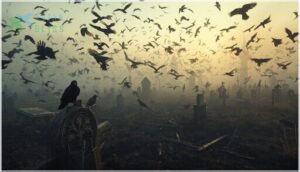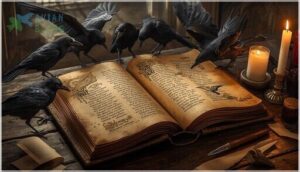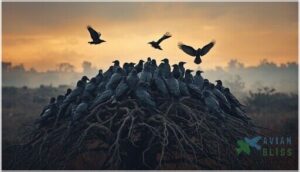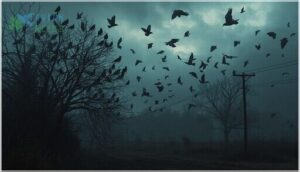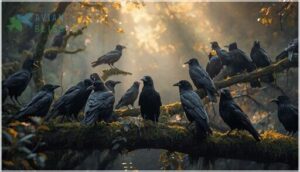This site is supported by our readers. We may earn a commission, at no cost to you, if you purchase through links.
You spot them on power lines, in parking lots, and gathered around dumpsters—those sleek black birds with their unmistakable caws. But when crows assemble in groups, they’re called something that sounds straight out of a crime novel: a murder.
The term dates back to medieval times, when people connected crows with death and bad omens, partly because these clever birds didn’t shy away from scavenging battlefields and cemeteries. While the name might sound dark, it tells us more about human superstition than actual crow behavior.
These highly intelligent birds gather for practical reasons like finding food, staying warm, and protecting each other from predators. Understanding why crows flock together reveals fascinating details about their social structure, problem-solving abilities, and the important role they play in our ecosystems.
Table Of Contents
- Key Takeaways
- Why Are Crows Called a Murder?
- How Many Crows Are in a Murder?
- Why Do Crows Flock Together in Groups?
- When Do Crows Gather in Large Numbers?
- Understanding Crow Social Structure and Behavior
- Other Common Collective Nouns for Birds
- Are Crows as Ominous as Their Name Suggests?
- Frequently Asked Questions (FAQs)
- Why is a group of crows called a murder?
- What is a group of crows called?
- How many names can you use to describe a group of crows?
- What is a collective noun for Crows?
- Are crows a genus?
- How many types of crows are there?
- What is a flock of crows called?
- Are crows a collective noun?
- What are some common collective names for Crows?
- What is a group of ravens called?
- Conclusion
Key Takeaways
- A group of crows is famously called a “murder,” a term rooted in medieval folklore and old hunting traditions.
- Crows gather in groups for practical reasons like finding food, staying warm, and protecting themselves from predators.
- These birds show complex social structures, with family groups, helpers, and massive communal roosts, sometimes numbering in the thousands.
- Despite their dark reputation, crows play important roles in ecosystems by removing carrion, controlling pests, and dispersing seeds.
Why Are Crows Called a Murder?
The term “murder of crows” sounds dark and dramatic, but it didn’t come from nowhere. This unusual name has its roots in old folklore, real-world observations, and historical language traditions.
Let’s look at the three main reasons why crows earned such an ominous collective noun.
Medieval Folklore and Death Symbolism
Throughout medieval folklore, crows became deeply entwined with death symbolism. They were seen as underworld messengers and omens of death, especially when their harsh caws echoed near homes. Their jet-black feathers reinforced this visual symbolism, while witchcraft beliefs linked them to sorcery and curses.
These dark associations in medieval folklore directly influenced the origin of the term “murder of crows.” Crows also served as a messenger of change, perceived to live in the void between worlds.
Battlefield and Cemetery Scavenging Behavior
Beyond folklore, crows earned their grim reputation through observable behavior. You’ll find them scavenging battlefields and cemeteries, where historical accounts describe dense flocks feeding on exposed human remains. Their sensory cues help them spot carcasses quickly, and learning fidelity means they remember profitable food sources. Landscape scavenging studies confirm crows dominate carcass removal in human-modified areas, making them efficient food scouting specialists:
- Flocks arrived on battlefields within days, covering thousands of corpses
- Cemetery observations showed crows feeding on shallow or disturbed graves
- UK experiments proved crows removed 70% of placed animal carcasses
- Roadkill and refuse demonstrate their adaptability to human food sources
- Spatial memory allows them to revisit reliable scavenging locations repeatedly
This highlights their role in important ecosystem services.
Historical Hunting Manuals and Terms of Venery
If you’re curious why “murder” stuck, blame medieval English hunting books and their fascination with poetic names. The Book of Saint Albans, packed with terms of venery, gave crows their infamous label.
These collective nouns weren’t just for hunters—they signaled social status and wit. Manuscript evidence shows the Albans influence still shapes the modern persistence of these vivid expressions.
How Many Crows Are in a Murder?
You might be wondering just how many crows make up a murder. The answer isn’t as simple as you’d think, since their group sizes change throughout the year.
Let’s look at the different ways crows gather together.
Family Groups During Breeding Season
Ever wondered how many crows make up a family group during breeding season? Crow family groups usually include a monogamous pair plus a handful of helpers—sometimes up to ten!
These helpers, often older offspring, stick around for years, boosting Breeding Output and shaping Group Composition. Their teamwork, or Helper Prevalence, is key to successful nests and strong Kin Dynamics.
Extended Family Units After Breeding
Once the breeding season wraps up, crow family groups don’t just dissolve—they expand. Extended family units can include up to fifteen birds, mixing parents, offspring, and sometimes even unrelated helpers, forming tight-knit “murders” with strong kin dynamics.
Here’s what shapes these extended family units:
- Offspring Association: Young crows often stick around their parents’ territory for years, delaying dispersal and contributing to future nests.
- Unit Composition: Most helpers are siblings or direct offspring, creating family-based social structures with multiple age classes.
- Reproductive Success: Helpers boost fledgling survival by feeding nestlings, which increases overall breeding output and parental longevity.
These spatial dynamics keep families cohesive, foraging close together within territories averaging about 500 meters across.
Massive Winter Roosts and Flocks
When winter arrives, crow flocks swell to astonishing sizes. Urban areas often host tens of thousands of crows, with cities like Portland and Bothell seeing up to 15,000 birds. Fort Cobb, Oklahoma, once recorded an extraordinary gathering of over 2 million crows. These massive winter crow behavior shifts are driven by seasonal timing, as breeding pairs abandon their territories to engage in communal roosting.
Communal roosting offers several benefits, including warmth, protection from predators, and the sharing of food sources. However, these large gatherings can also lead to human impacts, such as noise and droppings.
| Roost Type | Typical Size |
|---|---|
| Urban roosts | 10,000–15,000 crows |
| Rural roosts | Hundreds to thousands |
| Extreme roosts | 1,000,000+ birds |
| Family groups | 10–15 crows |
Why Do Crows Flock Together in Groups?
You might wonder why these birds seem to stick together like they’re at a family reunion. Crows don’t flock just because they enjoy the company, though that’s part of it.
They gather in groups for several smart, survival-based reasons that help them thrive in the wild.
Protection From Predators
Would you believe crows team up like a neighborhood watch? When you spot a murder of crows, you’re seeing Mobbing Behavior in action. Their Vigilance Dynamics mean more eyes scanning for danger, and Roosting Safety keeps them out of harm’s way. Through Predator Recognition and Cooperative Defense, crows boost their survival advantages against hawks, owls, and even humans.
- Loud group alarm calls
- Coordinated mobbing attacks
- Shared predator memories
Warmth During Cold Weather
Think of a Murder Of Crows as nature’s heated blanket. When temperatures drop, crows flock together, using huddling behavior in sheltered roost microclimates to save energy. Their smart habitat choices—dense trees or urban nooks—help trap warmth.
These collective nouns for crows aren’t just poetic; they reflect real roosting behavior and behavioral adjustments for energetic savings in winter.
Collective Foraging and Food Finding
Ever wonder how crows always seem to find the best snacks? Their foraging behavior is a team effort, powered by:
- Information Sharing at communal roosts
- Social Facilitation—copycat curiosity boosts food discovery
- Producer-Scrounger Roles, with some leading and others joining
- Fission-Fusion Dynamics, weaving groups together around fresh food sources
That’s collective nouns in action!
Social Bonding and Communication
Imagine this: crows use a Vocal Repertoire with over 20 call types, each woven into their social structure like threads in a tapestry. Through Individual Recognition and Coalition Formation, these birds build alliances, share secrets, and spark Prosociality. Network Dynamics shift as food and friends change, making avian communication a living, breathing part of crow behavior.
| Vocal Repertoire | Coalition Formation | Prosociality |
|---|---|---|
| 20+ call types | Stable alliances | Food sharing |
| Age/sex signals | Recruitment calls | Social tolerance |
| Individual cues | Coordinated action | Cooperative tasks |
| Contact/alarm | Agonistic bonds | Resource sharing |
When Do Crows Gather in Large Numbers?
Crows don’t just gather at random; their numbers swell during certain times and for specific reasons. If you’ve ever wondered why huge flocks suddenly appear, there’s a pattern behind it.
Here are the main times when you’ll spot crows coming together in large groups.
Seasonal Roosting Patterns
You’ll notice that roosting patterns shift dramatically with the seasons. American Crows form massive communal roosts primarily from November through March, driven by environmental cues like shorter days and colder temperatures.
These urban roost shifts mean most large gatherings now occur in cities rather than rural areas. Remarkably, some roosts show strong site fidelity, returning to the same locations for over a century. Winter crow behavior brings together hundreds to even two million birds.
Winter Flocking Behavior
Winter crow behavior really ramps up as temperatures drop. You’ll see flocks grow from just hundreds in fall to over 10,000 by mid-January. This seasonal flock buildup happens because:
- Urban roost persistence offers warmer microclimates (up to 1.4 degrees higher than surrounding areas)
- Roost site selection favors tall trees with broad crowns for crowding together
- Foraging information exchange helps crows share intel about reliable food sources
Some winter roosts even hit two million birds.
Daily Roosting Routines
While massive winter numbers grab your attention, the daily roosting behavior of crows follows a precise schedule. You’ll see them arrive at urban roosting sites 30 to 90 minutes before sunset, then depart around dawn—often traveling 10 to 20 km between roost and feeding areas. This commute pattern shifts with seasonal changes, with spring bringing shorter distances as breeding territories become home base.
| Time of Day | Crow Activity | Distance Traveled |
|---|---|---|
| Evening (pre-sunset) | Gathering at staging areas | Up to 18 km to roost |
| Night | Minimal movement after settling | Within roost trees |
| Dawn | Departing in small groups | 10–20 km to feeding zones |
Understanding Crow Social Structure and Behavior
Crows aren’t just smart birds that gather in groups—they’re actually organized, social creatures with surprisingly complex family lives. Their social structure goes beyond simple flocking, involving long-term partnerships, cooperative parenting, and cognitive abilities that rival some primates.
Let’s look at what makes crow society so fascinating.
Monogamous Pairs and Family Bonds
Unlike many birds that pair for a single season, crows form long-term pair bonds that last for years—sometimes an entire lifetime. You’ll find these monogamous pairs at the heart of crow social structure.
In New York studies, males sired about 82% of their nest’s offspring, showing strong genetic monogamy levels.
Young crows often stay with parents for up to six years, delaying dispersal while strengthening family ties and inclusive fitness benefits.
Cooperative Breeding and Helper Crows
Beyond monogamous pairs, you’ll often find helper crows—young adults that stick around to support their parents’ breeding efforts instead of striking out solo. Delayed dispersal happens when environmental constraints, like habitat saturation, make it tough to claim new territory.
These helpers boost breeding success rates by feeding chicks and defending nests, showcasing the notable social coordination within crow family groups.
Intelligence and Problem-Solving Abilities
Crows rank among the smartest birds on the planet, and that’s not just folklore. Their causal reasoning lets them avoid traps and plan several steps ahead, relying on working memory and dense neural substrates that rival primates.
You’ll see them using tools to solve multi-stage problems—some even select sticks to grab stones, then use those stones to reach food. Individual variation means some crows master tasks faster than others, showcasing avian intelligence at its finest.
Facial Recognition and Memory
Among the most stunning displays of avian intelligence, you’ll find crows can recognize your face and remember whether you’ve been a friend or foe—for over a decade. Neural face circuits in their forebrain distinguish threatening faces from caring ones, triggering alarm calls that spread through social memory transmission.
Crows can recognize your face and remember for over a decade whether you’ve been friend or foe
Limits of recognition are surprisingly few; corvids teach their young which humans to avoid, maintaining long-term memory across generations.
Other Common Collective Nouns for Birds
Crows aren’t the only birds with creative collective nouns that sound like they came straight out of a poetry book. Birds have some of the most colorful group names in the animal kingdom, many of which date back centuries to hunting traditions and folklore.
Let’s look at a few standout examples and how these terms are used today.
Examples of Poetic Bird Collective Nouns
You’ll find bird venery rich with figurative language and poetic origins. A murmuration of starlings describes those mesmerizing aerial clouds at dusk, while an exaltation of larks captures their ascending song flights. Parliament of owls refers to their wise, assembly-like gatherings.
Other poetic names for animal groups include a flamboyance of flamingos, an ostentation of peacocks, and a charm of finches—all examples of collective nouns rooted in medieval imagery.
Modern Vs. Traditional Usage
While “murder of crows” enjoys widespread media representation and reference codification in collective noun lists, everyday language tells a different story. Scientists and bird-watchers generally use “flock” in routine observations, reserving the dramatic medieval term for stylistic effect.
You’ll notice modern examples of collective nouns shifting between poetic tradition and practical clarity, with group names evolving as our understanding of crow intelligence deepens.
Are Crows as Ominous as Their Name Suggests?
Despite their dark reputation, crows aren’t the sinister creatures folklore makes them out to be. These birds actually play important roles in their ecosystems, and their intelligence rivals some primates.
Let’s look at why crows deserve a second chance beyond the spooky stories.
Ecological Benefits of Crow Flocks
Despite their dark reputation, crows play essential ecological roles you mightn’t expect.
A flock of crows provides pest regulation by consuming thousands of agricultural pests per season, including caterpillars and grubs. As scavengers, they excel at carrion removal, reducing disease spread while accelerating nutrient cycling.
They also contribute to seed dispersal and support broader food webs, making their environmental benefits substantial.
Intelligence and Adaptability
Beyond their ecological benefits, crows demonstrate impressive cognitive abilities that rival many primates. You’ll find them using tools to solve problems, recognizing individual human faces for years, and even “counting” out loud in controlled studies.
Their urban adaptability showcases impressive problem-solving and social learning, with city-dwelling crows adjusting nesting sites and breeding schedules to thrive alongside humans.
Moving Beyond Dark Folklore
The dark folklore and superstition surrounding crows stems from their medieval reputation as death omens, reinforced by centuries of battlefield scavenging.
Yet modern education initiatives are shifting public perception toward a balanced view that celebrates their ecological contributions.
As you recognize crows’ intelligence and urban integration, you’re joining a movement that replaces old superstitions with wonder, reframing the dramatic collective nouns for crows—including that famous “murder”—as fascinating rather than frightening.
Frequently Asked Questions (FAQs)
Why is a group of crows called a murder?
The term traces back to medieval folklore and death symbolism. Crows scavenging battlefields and cemeteries linked them to mortality, while 15th-century hunting manuals codified “murther of crowes” as their collective noun.
What is a group of crows called?
You’ve probably heard crows described by all sorts of wild collective nouns—murder, mob, horde, even cawcus—but the most iconic is definitely a murder of crows.
How many names can you use to describe a group of crows?
You can choose from at least 10–12 documented collective nouns for crows, including murder, flock, horde, mob, muster, parcel, parliament, hover, conspiracy, and storytelling, depending on traditional venery or modern preferences.
What is a collective noun for Crows?
You’ll find dozens of collective nouns for crows in medieval hunting manuscripts, but “murder of crows” and “flock of crows” dominate today’s usage—though “horde,” “mob,” and “parliament” still pop up occasionally.
Are crows a genus?
Yes, crows belong to the genus Corvus within the Corvidae family. This genus includes roughly 50 crow species worldwide, plus ravens and rooks—all sharing common ancestry as highly intelligent corvids.
How many types of crows are there?
Despite their reputation as uniform black birds, the genus Corvus contains roughly 50 crow species worldwide.
These corvids show considerable global distribution, from American crows to specialized island endemics, each adapted to regional environments.
What is a flock of crows called?
A flock of crows is most often called a “murder,” but you’ll also hear terms like “mob,” “horde,” or simply “flock” in everyday birding and scientific contexts.
Are crows a collective noun?
Crows” isn’t a collective noun—it’s a regular plural. However, “murder” in “murder of crows” is a collective noun phrase, a term of venery from medieval hunting manuals, now recognized in dictionary status with flexible verb agreement.
What are some common collective names for Crows?
You’ll most commonly hear “murder of crows” or “flock of crows” used in everyday conversation.
Poetic terms like “horde,” “muster,” “brood,” and “clan” also describe crow groups, though they’re less frequent in modern usage.
What is a group of ravens called?
Ever wondered why a group of ravens is called an “unkindness”? This Raven collective noun comes from old folklore, but today, most people just say “flock.”
Modern usage reflects Raven behavior, not those dark Unkindness origins.
Conclusion
Like a detective in a trench coat, you’ve uncovered why a group of crows is called a murder—an old word shaped by superstition, not science. These birds gather for warmth, safety, and teamwork, not mischief.
So next time you spot a “murder” perched above, remember you’re witnessing considerable intelligence and social bonds, not a scene from a gothic novel. The name may linger, but your understanding now flies beyond folklore, grounded in the true nature of crows.
- https://www.birdspot.co.uk/bird-brain/why-is-a-group-of-crows-called-a-murder
- https://garyborders.com/pages/a-murder-of-crows-a-wake-of-vultures/
- https://lenichoir.org/fr/2013/04/05/a-murder-of-crows-a-parliament-of-owls/
- https://animals.howstuffworks.com/birds/what-is-a-group-of-crows-called.htm
- https://blog.gardenwildlifedirect.co.uk/collective-nouns-for-birds/



